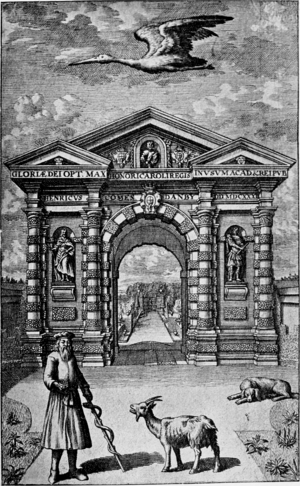Jacob Bobart the Younger facts for kids
Jacob Bobart (born August 2, 1641 – died December 28, 1719) was an English botanist. He was a plant expert who followed in his father's footsteps, working at a famous garden in Oxford.
Contents
A Life Among Plants: Jacob Bobart's Story
Jacob Bobart was the younger son of a man also named Jacob Bobart, who was a well-known botanist too. Jacob Jr. was born in Oxford. He took over his father's job as the boss of the Physic Garden. This garden was a special place where plants were grown for medicine and science.
After Dr. Robert Morison passed away in 1683, Jacob Bobart also started teaching about plants as a professor. In 1699, he helped publish the third part of a big book called Historia Plantarum. The second part had come out in 1680, but the first part was never printed.
The Famous "Dragon" Trick
There's a funny story about Jacob Bobart from around 1704. A writer named Zachary Grey wrote about it in his Notes on Hudibras. Bobart found a dead rat in the Physic Garden. He was very clever and made it look like a dragon! He changed its head and tail. Then, he used sharp sticks to stretch its skin on the sides, making it look like wings. He let it dry until it was very hard.
Many smart people immediately thought it was a real dragon! One person even sent a detailed description of it to Dr. Antonio Magliabechi, who was a librarian for the Grand Duke of Tuscany. People even wrote poems about this amazing "dragon." But in the end, Mr. Bobart admitted it was just a trick. Even so, everyone thought it was a brilliant piece of art. It was even placed in the museum or anatomy school at Oxford.
Later Years and Resignation
While he was in charge of the garden, Jacob Bobart created a "hortus siccus". This is a collection of dried plants, like a big scrapbook, which was popular at the time. His collection filled twelve large books and is still kept at the garden today.
In 1692, he tried to get a job as the curator of the Apothecaries' Garden in Chelsea, but he didn't get the position. In July 1719, a man named Consul William Sherard wrote that the Vice-chancellor, Robert Shippen, had forced Bobart to leave his job. Bobart was called "my old master" by Sherard and was in poor health at the time. Dr. E. Sandys then took over his role. Sherard wrote, "I am surprised the vice-chancellor hath obliged Mr. Bobart to resign his place... they ought to have let him spend the short remainder of his time in the garden." Jacob Bobart passed away on December 28, 1719, and was buried two days later.
Bobart's Legacy in Botany
Jacob Bobart left behind many important notes and letters. Among the Sherardian letters in the library of the Royal Society, there are fourteen letters from Bobart to Consul Sherard. Also, in the 'Sloane MS.,' No. 3343, at the British Museum, you can find many of Bobart's notes about gardening.
An old copy of Bauhin's Pinax, which is a list of plants, has many notes added by Bobart. This book is now in the botanical department of the Natural History Museum in London. There's also a copy of the Oxford Garden Catalogue with some of his additions.
The plant group (genus) called Bobartia was named in honor of both Jacob Bobart and his father by the famous scientist Linnæus in his book Amœnitates Academicæ. This shows how important their work was in the world of plants.


